Andorra
Serie 1: 2016-20..
Although Andorra is using the Euro since 2002, they don't have there own Euro coins but are using Spanish and French Euro coins. However on January 1, 2014 they will issue their own Euro coins.
The 1 c., 2 c. and 5. c. features the image of a Chamois. The 10 c. 20 c. and 50 c. shows Pantocrator of St. Martin of Cortinada and the Romanesque church of Santa Coloma. The 1 Euro shows the 'Casa de la Vall' and the 2 Euro the National Arms on Andorra. |  | Andorra
Serie 1: 2016-20..
Hoewel Andorra al euromunten gebruikt sinds de invoering van de euro, heeft het geen eigen euromunten maar gebruikt het de Spaanse en Franse euromunten. Echter op 1 januari 2014 begin het met uitgeven van eigen euro munten
De munten van 1 c., 2 c. en 5 c. dragen de afbeelding van een gems. De 10 c., 20 c. en 50 c. de afbeelding van Pantocrator van St. Martin van Cortinada en de Romaanse kerk van Santa Coloma. DE 1 euro heeft een afbeelding van het 'Casa de la Vall' terwijl de 2 euro het nationale wapen van Andoora draagt. |
|
Austria
Serie 1: 2002-20..
The national side of each Austrian Eurocoin is different.
The copper colered coins carry typical Alp flowers, the Enzian, Eddelweiss and Alp-primrose to demonstrate Austrian concern for the environment.
The 10 c. shows the gothic Stephansdom Church, the 20c. Palace Belvedere and the 50 c. shows the Secession.
The 1 Euro shows the portret of Motzart and the 2 Euro the Nobel price winner Bertha von Suttner. | 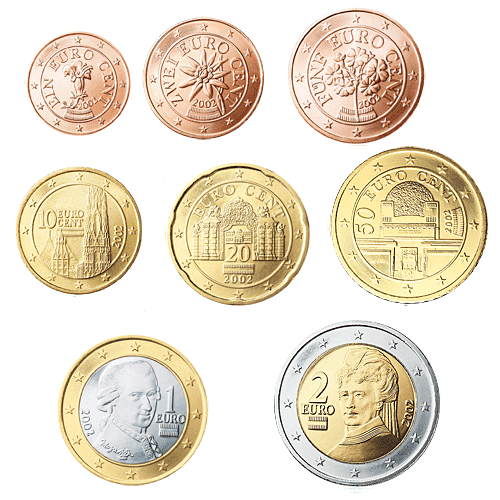 | Oostenrijk
Serie 1: 2002-20..
De nationale zijde van elke Oostenrijkse euromunt is verschillend.
De koperkleurige munten hebben een afbeelding van een typische Alpen bloem, resp. Enzian, Edelweiss en Alpenroos om de verbondenheid met de natuur weer te geven.
Op de 10 c. staat de gotische Stephansdomkerk, op de 20 c. Paleis Belvedere en op de 50 c. staat de Secession.
Op de 1 euro prijkt het portret van Mozart en de 2 euro in voorzien van nobelprijs winnaar Bertha van Suttner. |
|
Belgium
Serie 1: 1999-2007
The national side of the Belgian Euro coins is the same for all coins, the portrait of the Belgian King Albert II designed by Luc Luycks.
The only text on the coin is a crowned A, the monogram of the King, so there has to be only one type of Belgian Euro coin for both the Flanders and the Walones. | 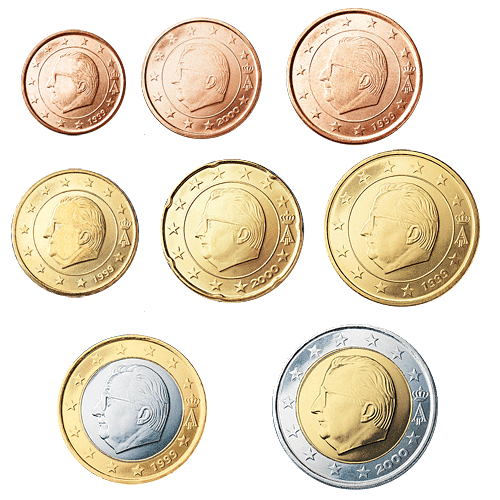 | België
Serie 1: 1999-2007
De nationale zijde van alle Belgische euromunten is gelijk, het protret van Koning Albert II ontworpen door Luc Luycks.
De enige tekst op de munt is een gekroonde A, het monogram van de koning, zodat er slechts een model euromunt is geschikt voor zowel Vlaanderen en Walonië. |
|
Belgium
Serie 2: 2008
Due to a regulation from the European Central Bank that all national sides has to show the name of the issueing country or an abbreviation of that name the national side of the Belgium Euro coins changed in 2008. |  | België
Serie 2: 2008
Als gevolg van regelgeving van de Europeese Centrale Bank dat alle euro munten op de nationale kant de naam van het uitgevende land of een afkorting hiervan moeten dragen is het ontwerp van de Belgische euro munten gewijzigd in 2008. |
|
Belgium
Serie 3: 2009-2013
Since the design of 2008 didn't comply with the design rules of the E.C. the national side of the Belgium euro coins now show the image of King Albert II like it was on the euro coins before 2008. |  | België
Serie 3: 2009-2013
Aangezien het ontwerp van 2008 in strijd was met de regels van de E.C. toont de nationale kant van de Belgische euromunten weer het portret van Koning Albert II zoals op de euromunten van voor 2008. |
|
Belgium
Serie 4: 2014-20..
Since the design of 2008 didn't comply with the design rules of the E.C. the national side of the Belgium euro coins now show the image of King Albert II like it was on the euro coins before 2008. |  | België
Serie 4: 2014-20..
Aangezien het ontwerp van 2008 in strijd was met de regels van de E.C. toont de nationale kant van de Belgische euromunten weer het portret van Koning Albert II zoals op de euromunten van voor 2008. |
|
Cyprus
Serie 1: 2008-20..
The national side of the 1, 2 and 5 cents bears a picture of a Mouflon.
The 10, 20 and 50 cent bears a picture of a 'Kyrenia' ship, symbolizing the sea.
The 1 and 2 Euro shows the 'Idol of Pomos'. |  | Cyprus
Serie 1: 2008-20..
De nationale kant van de 1, 2 en 5 eurocent toont een afbeelding van een Moeflon.
De 10, 20 en 50 eurocent toont een 'Kyrinia' schip en symboliseert de zee.
De 1 en 2 euro krijgt de afbeelding van het 'Idool van Pomos'. |
|
Estonia
Serie 1: 2011-20..
The national side of the Euro coins from Estonia are all the same and shows the map of Estonia. | 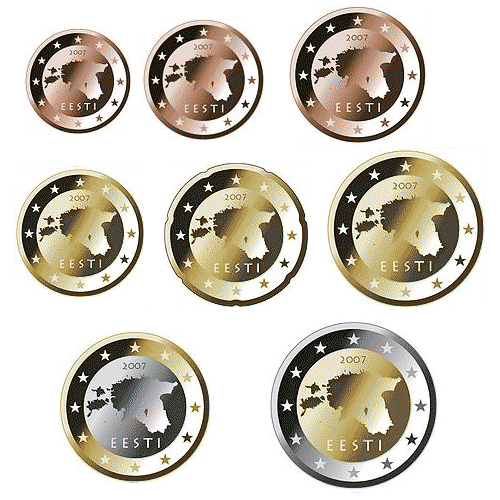 | Estland
Serie 1: 2011-20..
Op de nationale kant van alle euromunten uit Estland zie je de kaart van het land. |
|
Finland
Serie 1: 1999-2006
The national side of the Finnish Eurocent coins are decorated with the Finnish Lion.
The 1 Euro coin carry some Swans, a highly appreciated Bird in Finland.
The 2 Euro coins shows the flower of the peat berry, a protected species which is found in the northern regions of Finland.
This series has the mintmark M on the national side of the coins. |  | Finland
Serie 1: 1999-2006
De nationale zijde van alle Finse eurocentmunten is gedecoreerd met de Finse leeuw.
De 1 euromunt is voorzien van zwanen, een zeer gewaarde vogel in Finland.
De 2 euromunt toont de bloesem van de veenbes, een beschermde bessensoort die in het noorden van Finland voorkomt.
Deze serie heeft met muntmeestersteken M op de nationale zijde van de munt. |
|
Finland
Serie 2: 2007-20..
In 2007 the mint mark changed from M to the logo of the Finnish Mint which is now situated between the '8 o-clock' and the '9 o-clock' star.
Also FI was added to comply with regulations of the ECB that each coins should bear the identity of the issuing country. | 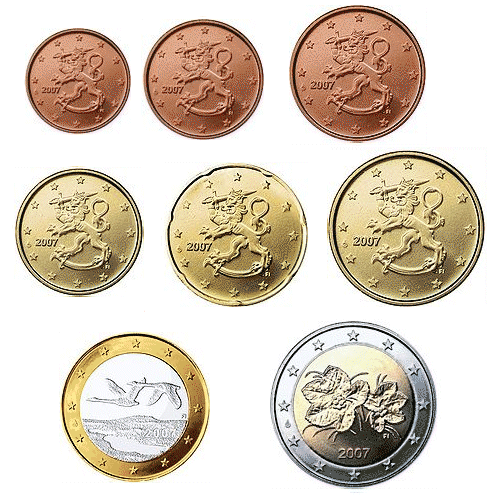 | Finland
Serie 2: 2007-20..
In 2007 is het muntmeesters teken gewijzigd van M in het logo van de Finse Munt en is geplaatst tussen de '8 uur' en de '9 uur' ster aan de rand.
Tevens is FI toegevoegd om te voldoen aan de regel van de ECB dat elke munt de identiteit van het uitgevende land moet dragen. |
|
France
Serie 1: 1999-2021
The national side of the French Euro coins shows great resemblance to the former Franc coins.
All copper colored coins carry the portrait of Marianne, the French national symbol.
The sowing woman on the 10c., 20c. and 50c. symbolizes Hope, Freedom and Generosity and was also found on the former 1 Franc coin.
The stylized tree on the 1 and 2 Euro coins symbolizes Growth, Life and Nature and is surrounded by the words Liberté, Egalité et Fraternité. | 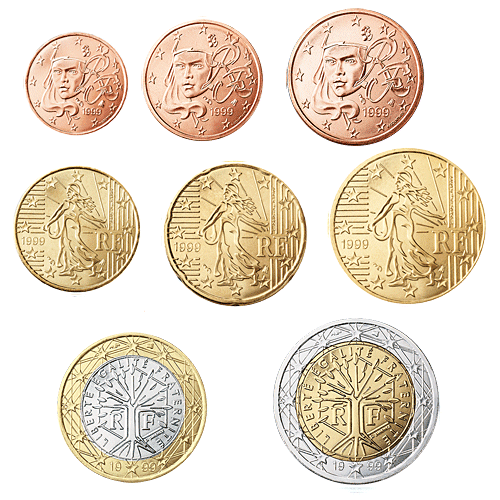 | Frankrijk
Serie 1: 1999-2021
De nationale zijde van alle Franse euromunten toont grote overeenkomst met de voormalige Franc munten.
Alle koper kleurige munten dragen het portret van Marianne, het nationale symbool van Frankrijk.
De zaaiende vrouw op de 10c., 20c. en 50c. symboliseert hoop vrijheid en gulheid en stond ook op de voormalige 1 Franc munt.
De gestileerde boom op de 1 en 2 euromunt staat voor groei, leven en natuur en word omringt door de woorden Liberté, Egalité et Fraternité. |
|
France
Serie 2: 2022-20..
|  | Frankrijk
Serie 2: 2022-20..
|
|
Germany
Serie 1: 1999-20..
The national side of the German Euro coins caries three well known symbols of Germany.
The 1c., 2c. and 5c. show an oak twig like the Pfennig coins used to do.
The 10c., 20c. and 50c. carry the Branderburgergate and the 1 and 2 Euro a German Eagle.
Besides these symbols, there is a letter to indicate the City where the coins are made.
A = Berlin
D = Munich
F = Stuttgart
G = Karlsruhe
J = Hamburg | 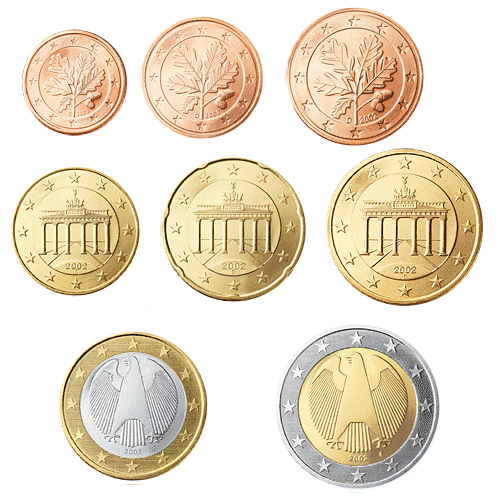 | Duitsland
Serie 1: 1999-20..
De nationale zijde van alle Duitse euromunten zijn voorzien van de drie bekende Duitse symbolen.
De 1c., 2c. en 5c. zijn voorzien van eikenbladeren zoals ook op de voormalige pfennig munten.
De 10c., 20c, en 50c. zijn voorzien van de Branderburgertor en op de 1 en 2 euromunten prijkt de Duitse adelaar.
Naast de nationale symbolen staat er ook een letter op deze zijde die aangeeft in welke plaats de munten gemaakt zijn.
A = Berlijn
D = Munchen
F = Stuttgart
G = Karlsruhe
J = Hamburg |
|
Greece
Serie 1: 1999-20..
The national side of the Greece Euro coins shows eight different motives.
The 1c. shows an 449 BC sailing ship, the 2c. an 1821 Corvette while the 5 c. carries a modern Greek tanker.
The 10c. carries the portrait of the politician Rigas Velestinlis-Fereos (1757-1798), the 20c. the portrait of Johannis Capodistrias (1776-1831) and the 50c. shows the portrait of Eleftherios Venizelos (1864-1936).
The 1 Euro shows the famous Athens Owl and the 2 Euro the mythological picture of Europa's abduction by Zeus in the form of a bull. The Greece Euro coins are not only made in Greece but partially also in France (F) Spain (E) and Finland (S). These can be identified by a letter in a star on the Greece side of the coin.
1 c.: F in star left of Year
2 c.: F in star under Year
5 c.: F in star right of Year
10 c.: F in star under Year
20 c.: E in star under Year
50 c.: F in star above Year
1 ë. and 2 ë: S in star in Year | 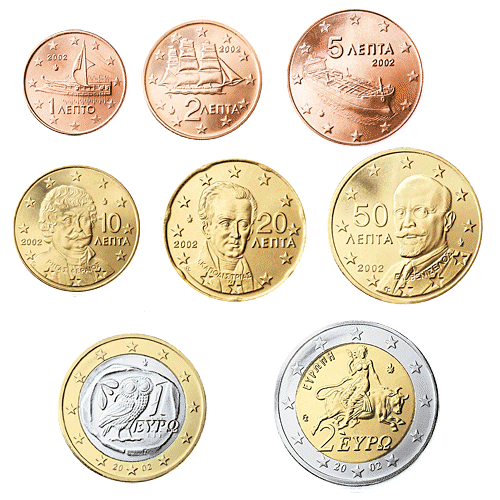 | Griekenland
Serie 1: 1999-20..
De nationale zijde van de Griekse euromunten toont 8 verschillende motieven.
De 1c. een zeilschip van 446 VC, de 2 c. een korvet uit 1821 terwijl de 5c. een moderne Griekse tanker toont.
De 10c. draagt het portret van de politicus Rigas Velestinlis-Fereos (1757-1798), de 20c. het portret van Johannis Capodistrias (1776-1831) en de 50c. het portret van Eleftherios Venizelos (1864-1936).
De 1 euro toont de beroemde uil van Athene en de 2 euro de mythologische afbeelding van de ontvoering van Europa door Zeus in de vorm van een stier.
De Griekse euro's worden niet alleen in Griekenland geslagen maar gedeeltelijk ook in Frankrijk (F), Spanje (E) en Finland (S), deze zijn identificeerbaar aan een letter in een ster aan de Griekse kant van de euro.
1 c.: F in ster links van jaar
2 c.: F in ster onder jaar
5 c.: F in ster rechts van jaar
10 c.: F in ster onder jaar
20 c.: E in ster onder jaar
50 c.: F in ster onder jaar
1 ë. en 2 ë.: S in ster in jaartal |
|
Ireland
Serie 1: 2002-20..
The national side of the Irish Euro coins is the same for all coins and shows the Irish symbol, the Celtic Harp and the word Eire, which is the correct Gaelic spelling for Ireland.
The harp emphasizes the Celtic background of Ireland and was already used by the Druids in the 8th Century. | 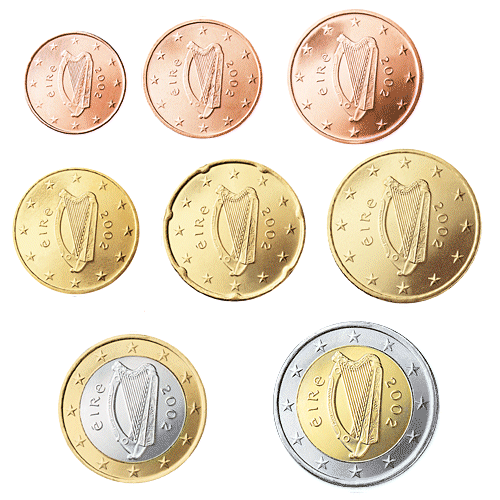 | Ierland
Serie 1: 2002-20..
De nationale zijde van alle Ierse euromunten is gelijk en toont het nationale symbool van Ierland, een Keltische harp en het woord Eire, wat de juiste spelling van Ierland is in geallic.
De harp benadrukt de Keltische achtergrond en werd al door druëden in de 8ste eeuw bespeeld. |
|
Italy
Serie 1: 2002-20..
The 1c. shows the Castle del Monte of Apulia, the 2c. the Mole Antonelliana of Turin and the 5c. the Colloseum of Rome.
The 10c. shows the face of the Venus of Botticelli, the 20c. the Simbolo of the Galaria d'Arte and the 50c. a statue of Marc Aurel.
The 1 euro carries L'Uomo of Leonardo da Vinci and the 2 euro a portrait of the poet Dante Alighieri. | 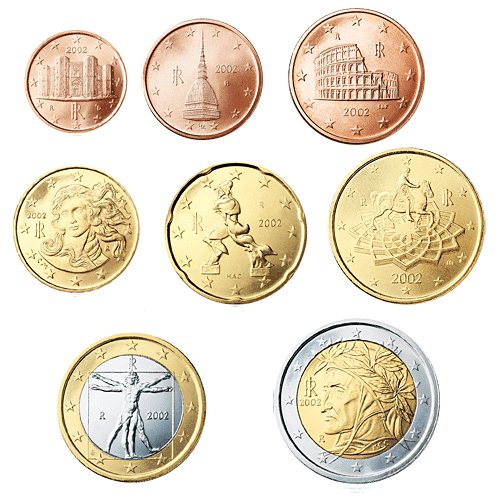 | Italië
Serie 1: 2002-20..
De nationale zijde van alle Italiaanse munten is verschillend.
De 1c. toont het kasteel del Monte in Apulia, de 2 c. de Mole Antonelliana te Turijn en de 5c. het Colloseum in Rome.
De 10c. toont het gezicht van de Venus van Botticelli, de 20c. het Simbolo van de Galaria d'Arte en de 50c. een standbeeld van Marc Aurel.
Op de 1 euro staat L'Uomo van Leonardo da Vinci en op de 2 euro een portret van de dichter Dante Alighieri. |
|
Latvia
Serie 1:
The national design of the 1, 2 and 5 cent coins bears the small coat of arms of Latvia.
The 10, 20 and 50 cent coins show the great coat of arms of Latvia.
The folk maiden on the 1 and 2 Euro coin is the same design as appeared in the 5 Lats used when Latvia was independent in the 1920's. | 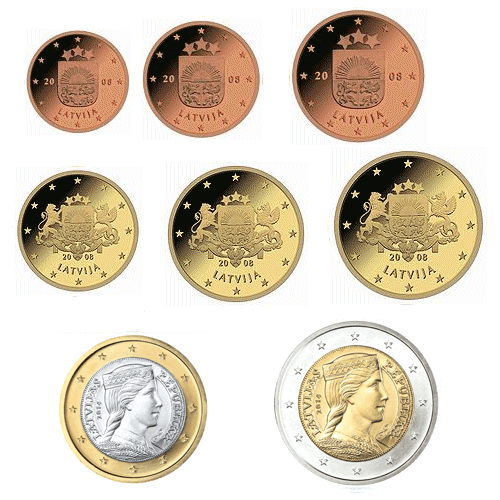 | Letland
Serie 1:
De nationale kant van de 1, 2 en 5 cent munten dragen het kleine wapen van Letland.
De 10, 20 en 50 cent het grote wapen van Letland.
De 1 en 2 euro toont een volksvrouw zoals ook gebruikt op de 5 lats in de onafhankelijke staat Letland in de jaren 20 van de vorige eeuw. |
|
Luxembourg
Serie 1: 2002-20..
Luxembourg has chosen for the same design on the national side of all Euro coins namely the portrait of Jean, the Grandduke of Luxembourg.
Besides the portrait all coins shows the word Letzebuerg. | 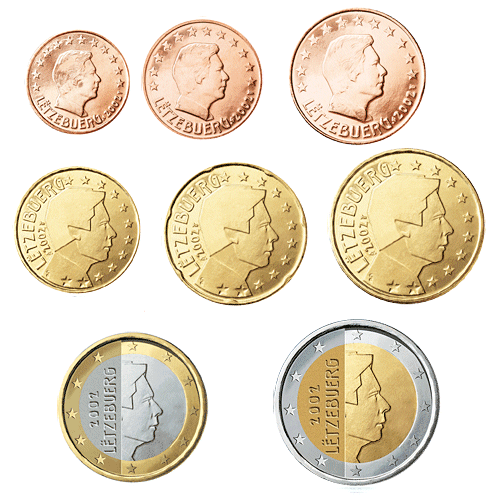 | Luxemburg
Serie 1: 2002-20..
Luxemburg heeft gekozen voor een zelfde afbeelding op de nationale zijde van alle munten namelijk het portret van Jean de Groothertog van Luxemburg.
Naast het portret staat op alle munten het woord Letzebuerg. |
|
Malta
Serie 1: 2008-20..
The design for the Maltese Euro coins has been selected by the people of Malta and was approved by the EU Commission.The 1, 2 and 5 cent bear the image of the prehistoric temple of Imnajdra. The 10, 20 and 50 cents the emblem of Malta. The 1 and 2 Euro shows the 8-pointed Maltese Cross. The coins will be produced by the 'Monnaie de Paris', de Mint of France. | 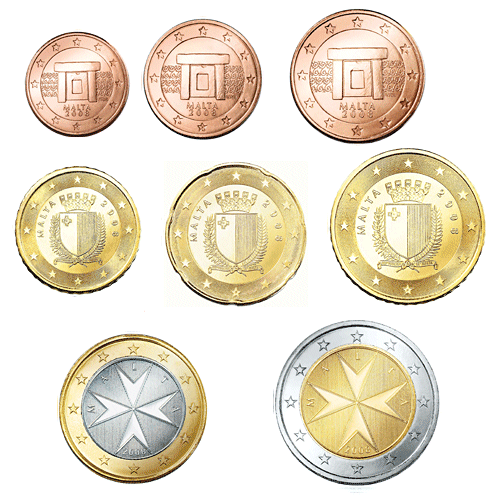 | Malta
Serie 1: 2008-20..
Het ontwerp van de Malteser euromunten is gekozen door het volk van Malta en goedgekeurd door de EU Commissie.De 1, 2 en 5 cent dragen de afbeelding van de prehistorische tempel van Imnajdra. De 10, 20 en 50 cent het embleem van Malta. De 1 en 2 euro tonen het 8-puntige Malteser kruis. De munten worden geproduceerd door de 'Monnaie de Paris', de munt van Frankrijk. |
|
Monaco
Serie 1: 2002-2005
The national side of the Euro coins from Monaco of 1c., 2c. and 5c, are carrying the coat of arms of The Grimaldi's, the founders of Monaco.
The 10c., 20c. and 50c. are showing the Grimaldi seal.
The 1 Euro shows the combined portrait of the Prince of Monaco Rainier III and the heritable Prince Albert. The 2 Euro show the portrait of Prince Rainier III.
All coins have the word MONACO on the top, 6 stars on each side and the Year on the bottom. |  | Monaco
Serie 1: 2002-2005
De nationale zijde van alle Monagaskische euromunten van 1c., 2c. en 5 c. dragen het familiewapen van de Grimaldi's, the stichters van Monaco.
De 10c., 20c. en 50c. tonen het zegel van de Grimaldi's.
De 1 euro het dubbel portret van Pins Rainier III en zijn erfopvolger Prins Albert. De 2 euro het portrat van Prins Rainier III.
Op alle munten staat boven aan het woord MONACO, links en rechts 6 sterren en het jaartal staat onder aan. |
|
Monaco
Serie 2: 2006-20..
In 2006 after the death of HSH Prince Reinier III the national side of the coins of Monaco has been changed. The 1c., 2c. and 5 c. still shows the coat of arms of the Grimaldi's. The 10c., 20c. and 50c. shows the sela of HSH Prince Albert. The 1 and 2 euro shows a picture of HSH Prince Albert. All coins now have 12 stars in a circle and the word MONACO and the year have moved inside the outer circle of stars. | 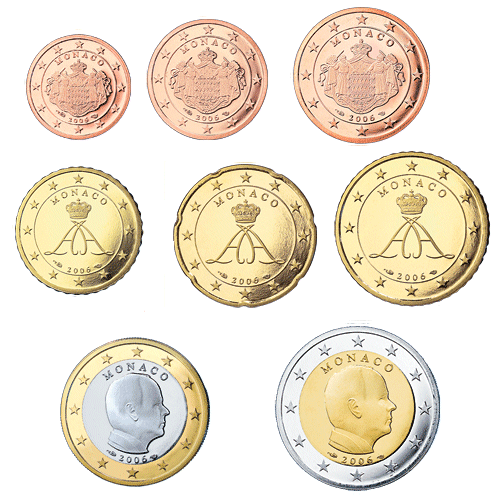 | Monaco
Serie 2: 2006-20..
In 2006, na de dood van Prins Reinier III is de nationale kant van de euromunten van Monaco gewijzigd.De 1c., 2c. en 5 c. dragen nog steeds het familiewapen van de Grimaldi's. De 10c., 20c. en 50c. tonen het zegel van Prins Albert. De 1 en 2 euro dragen een portret van Prins Albert. Alle munten hebben nu een ring met 12 sterren aan de buitenrand. Het woord MONACO en het jaartal is naar binnen verplaatst. |
|
Netherlands
Serie 1: 1999-2013
The national side of all the Dutch Euro coins shows, just like the coins from some other E.U. Countries the portrait of the head of State, Queen Beatrix.
Besides the portrait of the Queen all coins carry the text 'BEATRIX KONINGIN DER NEDERLANDEN'. | 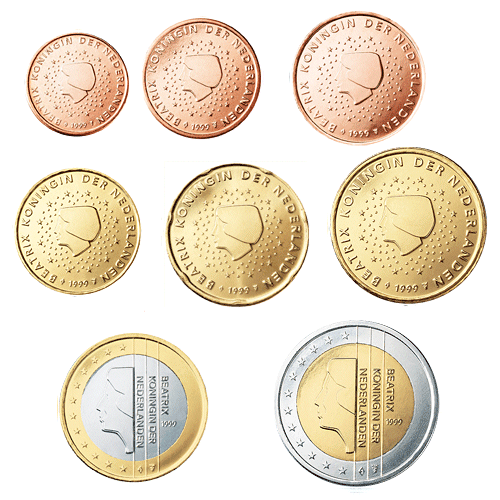 | Nederland
Serie 1: 1999-2013
De nationale zijde van alle Nederlandse euromunten is, net zoals die van een aantal andere E.U. landen, voorzien van het portret van het staatshoofd, Koningin Beatrix.
Behalve het portret van Koningin Beatrix staat op alle munten ook de tekst 'BEATRIX KONINGIN DER NEDERLANDEN'. |
|
Netherlands
Serie 2: 2014-20..
The second series of the Dutch Euro coins shows the portrait of the new head of State, King Willem Alexander, looking to the right. On the 1 c. till the 50 c. the effigy of the King is split in two by the text 'Willem Alexander Koning der Nederlanden'. On the 1 and 2 Euro coin the year and text 'Willem Alexander Koning der Nederlanden' is on the right, in front of the effigy of the King. |  | Nederland
Serie 2: 2014-20..
De nationale zijde van de tweede serie Nederlandse euromunten draagt het portret van het nieuwe staatshoofd, Koning Willem Alexander, kijkend naar rechts.Op de munten van 1c. tot 50c. is de afbeelding in gesplits door de tekst 'Willem Alexander Koning der Nederlanden'. Op de 1 en 2 euro staat het jaartal en de tekst 'Willem Alexnder Koning der Nederlanden rechts voor de afbeelding van de Koning. |
|
Portugal
Serie 1: 2002-20..
The national side shows a mixture of the national heritage and cultural background.
The 1c., 2c. and 5c. show the firts Royal Seal dated 1134 and the word Portugal.
The 10c., 20c. and 50c. show the Royal Seal dated 1142. The 1 and 2 euro carry the seal dated 1144.
The seals on all coins are surrounded by a circle of coats of arms and castles which is surrounded again by the 12 stars of the E.U. | 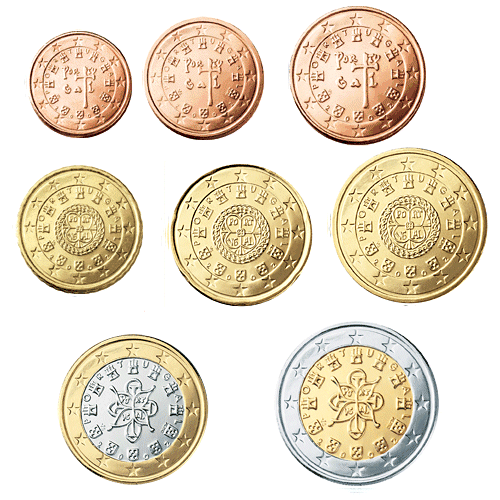 | Portugal
Serie 1: 2002-20..
De nationale zijde van alle Portugese euromunten tonen een mengeling van het nationale erfgoed en de culturele achtergrond.
De 1c., 2c. en 5c. tonen het nationale zegel gedateerd 1134. De 10c., 20c. en 50c. tonen het nationale zegel van 1142.
Op de 1 en 2 euro staat het zegel van 1144 centraal.
Rond de zegels staat op elke munt een cirkel met wapenschilden en kastelen en daaromheen weer de twaalf sterren van de E.U. |
|
San Marino
Serie 1: 2002-2016
The national side of all the Eurocoins from San Marino is different for all coins.
The 1c. shows the Il Montale tower, the 2c. the Liberty statue on the Piazza della Liberta and the 5 c. the La Guaita fortress.
On the 10c. you can see the Basilica del Santo, on the 20c. Saint Marino the father of the republic and on the 50c. the 3 towers of the fortress Monto Titano.
The 1 Euro bears the coat of arms of San Marino and the 2 Euro the gouvernement palace. | 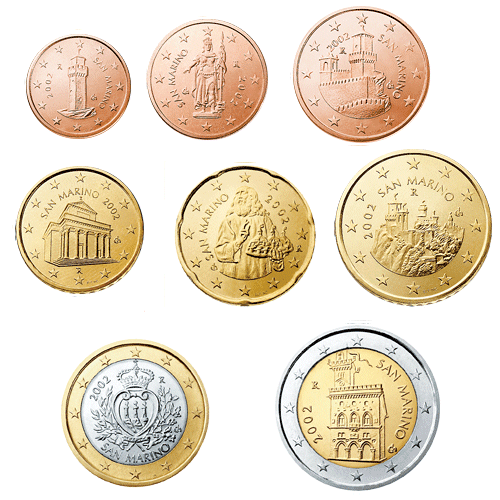 | San Marino
Serie 1: 2002-2016
De nationale zijde van alle euromunten uit San Marino zijn allemaal verschillend. De 1c. toont de Il Montale toren, de 2c. het Vrijheidsbeeld op de Piazza della Liberta en de 5 c. het La Guaita fort. Op de 10c. zie je de Basilica del Santo, op de 20c. Saint Marino de beschermheilige van de republiek en op de 50c. de 3 torens van het fort Monto Titano.
De 1 euro draagt het wapen van San Marino en de 2 euro het gouvernements paleis. |
|
San Marino
Serie 2: 2017-20..
In 2017, 15 Years after the Euro was introduced, San Marino has the design of the national side of the Euro coins. Like in the previous series all coins are different.
| 1 c. | The coat of arms of San Marino | | 2 c. | The town gate of San Marino | | 5 c. | The curch of Capuchin Friars | | 10 c. | The curch of Saint Francis | | 20 c. | The three towers of San Marino | | 50 c. | The founder of San Marino, Saint Marino | | 1 E. | The second tower of San Marino | | 2 E. | Sint Marino, this time from a painting of G.B. Urbinelli |
|  | San Marino
Serie 2: 2017-20..
In 2017, 15 jaar na de introductie van de euro munten, zal San Marino de national kant van de euromunten wijzigen. Ook nu zijn de afbeeldingen op elke munt verschillend.
| 1 c. | Het Wapen van San Marino | | 2 c. | De Stadspoort van San Marino | | 5 c. | De kerk van Capuchin Friars | | 10 c. | De kerk Sint Francis | | 20 c. | De drie torens van San Marino | | 50 c. | De stichter van San Marino, Sint Marino | | 1 E. | De tweede toren van San Marino | | 2 E. | Sint Marino, dit keer aan de hand van een schilderij van G.B. Urbinelli |
|
|
Slovakia
Serie 1: 2009-20..
The 1, 2 and 5 cent shows the image of Tatra Krivan Peak.The 10, 20 and 50 cent coins bear the image of the Bratislava Castle from the capitol of Slovakia. The double cross on three hills on the 1 and 2 Euro coins is one of the state symbols of Slovakia. |  | Slowakije
Serie 1: 2009-20..
De 1, 2 en 5 cent toont de Krivan top uit het Tatra gebergte.Op de 10, 20 en 50 cent staat een afbeelding van het Bratislava kasteel uit de hoofdstad van Slowakije. Het dubbele kruis op drie heuvels op de 1 en 2 euro munten is een van de nationale symbolen van Slowakije. |
|
Slovenia
Serie 1: 2007-20..
The national side of the Euro coins from Slovenia are different on all coins.
The 2 Euro shows the effigy of the poet Preëeren while the 1 Euro shows th effigy of the writer Trubar.
The 50c. shows the mountain Triglav under the constellation Cancer, the 20c. two Lippizaner horses and the 10c. the design for the parlaiment building.
The 5c. showes Grohar's painting Sower, the 2c. the ince Stone and the 1c. a stork. |  | Slovenië
Serie 1: 2007-20..
De nationale zijde van alle Sloveense munten is verschillend.
Op de 2 euro staat de beeltenis van de dichter Preëeren. De 1 euromunt toont een afbeeldingvan de schrijver Trubar.
Op de 50c. staat de berg Triglav onder het sterrebeeld Kreeft. De 20c. toont een afbeelding van Lipizaner paarden en de 10 c. de afbeelding van een ontwerp voor het parlements gebouw.
Op de 5c. staat het schilderij de Zaaier van Grohar, op de 2 c. de Steen der Prinsen en de op 1c. een ooievaar. |
|
Spain
Serie 1: 2002-2009
The national side of the Spanish Euro coins shows three different illustrations.
The 1c., 2c. and 5c. shows the pilgrimage church of Santiago de Compostela.
The 10c., 20c. and 50c. shows the portrait of the poet Miguel de Servantes.
And the 1 and 2 Euro shows the portrait of King Juan Carlos I. | 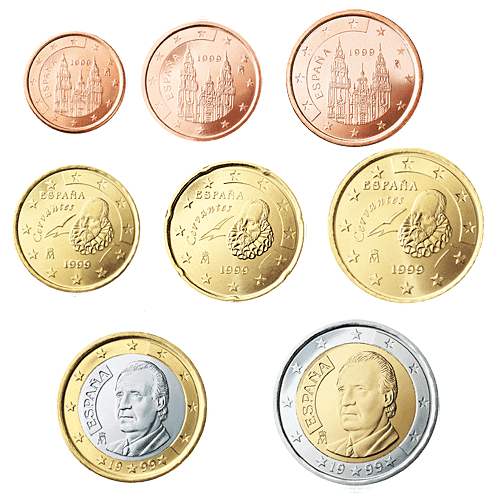 | Spanje
Serie 1: 2002-2009
De nationale zijde van alle Spaanse euromunten is voorzien van drie verschillende afbeeldingen.
De 1c., 2c. en 5 c. toont de pelgrims kerk van Santiago de Compostela.
De 10c., 20c. en 50c. toont het portret van de dichter Miguel de Servantes.
Op de 1 en 2 euro tenslotte staat het portret van Koning Juan Carlos I. |
|
Spain
Serie 2: 2010-2014
In 2010 the national side of the Spanish Euro coins changed in order to apply with the recommended guidelines from the European Committee.The effigy of Juan Carlos will stay the same, but the date on the 1 and 2 Euro coin will move to the inner part of the coins. The 12 stars will all be on the outside of the coins without a raised section. | 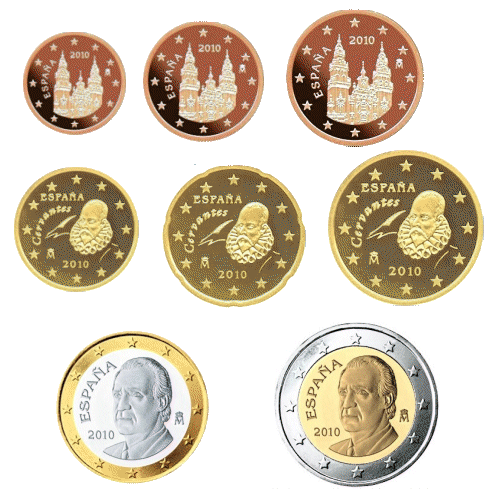 | Spanje
Serie 2: 2010-2014
In 2010 veranderde de nationale zijde van de Spaanse euromunten om zo te voldoen aan de aanbevolen richtlijnen van de Europese Commissie.De afbeelding van Juan Carlos blijft gelijk maar het jaartal van de 1 en 2 euro munten wordt verplaats naar het binnen gedeelte van de munt. De 12 sterren komen allemaal zonder verhoging op de munten. |
|
Spain
Serie 3: 2015-20..
Because of the abdication of King Juan Carlos in 2014, the 1 Euro and 2 Euro coins fron Spain will change 2015 and will bear the effigy of
King Felipe VI.
The 1c., 2c., 5c., 10c., 20c. and 50c. coins will stay the same. | 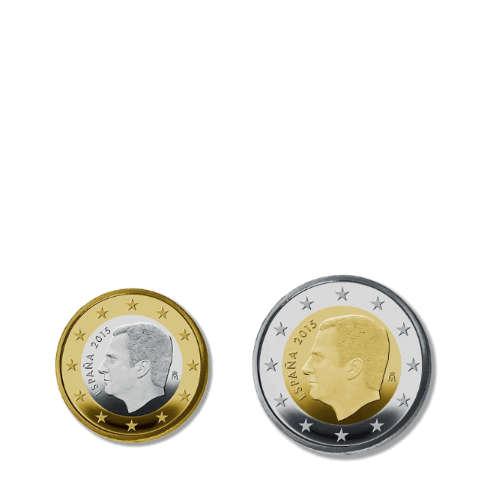 | Spanje
Serie 3: 2015-20..
Vanwege de troonsafstand van Koning Juan Carlos in 2014, zullen de 1 euro en 2 euro munten van Spanje in 2015 wijzigen en de afbeelding krijgen van
Koning Felipe VI.
De 1c., 2c., 5c., 10c., 20c. en 50c. munten blijven gelijk. |
|
Vatican
Serie 1: 2002-2004
The national side of all the Eurocoins from Vatican is the same and shows the portrait of His Holiness Pope John Paul II, head of the Katholic Church and monarch of the Vatican. | 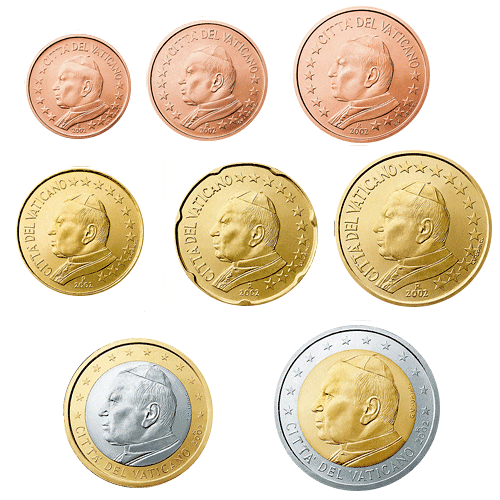 | Vaticaan
Serie 1: 2002-2004
De nationale zijde van alle euromunten uit het Vaticaan is gelijk en toont het portret van Zijne Heiligheid Paus Johannes Paulus II, hoofd van de Katholieke Kerk en monarch van het Vaticaan. |
|
Vatican
Serie 2: 2005
After the death of Pope John Paul II the Vatican issued a series of euro coins with the weapon of the acting Cardinal and the text 'Sede Vacante' on the national side. | 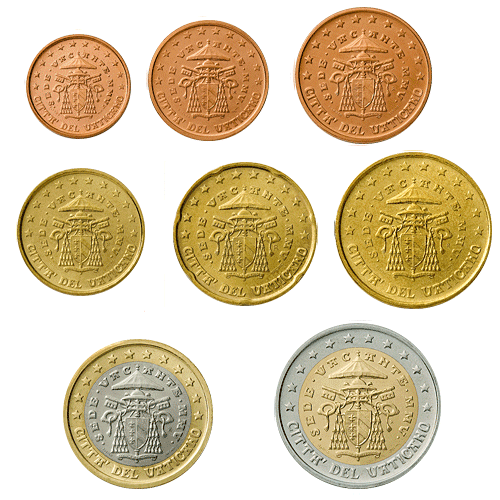 | Vaticaan
Serie 2: 2005
Na het overlijden van Paus Johannes Paulus II heeft het Vaticaan een serie euromunten uitgegeven met op de nationale kant een afbeelding van het wapen van de waarnemende kardinaal en de tekst 'Sede Vacante'. |
|
Vatican
Serie 3: 2006-2013
From 2006 until and including 2013 the Vatican issued coins with the image of Pope Benedict XVI. | 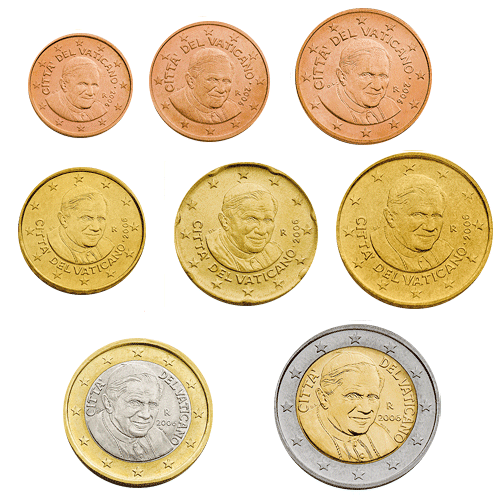 | Vaticaan
Serie 3: 2006-2013
Vanaf 2006 tot en met 2013 heeft het Vaticaan weer munten uitgegeven met de afbeelding van Paus Benedictus XVI. |
|
Vatican
Serie 4: 2014-2016
From 2014 the Vatican issued coins with the image of Pope Fransisco. |  | Vaticaan
Serie 4: 2014-2016
Vanaf 2014 heeft het Vaticaan munten uitgegeven met de afbeelding van Paus Fransiscus. |
|
Vatican
Serie 5: 2017-20..
Pope Francisco has expressed his wish to be no longer on the Euro coins from Vatican. Therefor starting in 2017 the Vatican will issue coins with the shield of Pope Francisco instead. |  | Vaticaan
Serie 5: 2017-20..
Paus Fransiscus heeft de wens te kennen gegeven niet langer op de euromunten van het Vaticaan te worden afgebeeld. In plaats daarvan zal het Vaticaan vanaf 2017 munten uitbrengen met het wapenschild van Paus Fransiscus. |
|